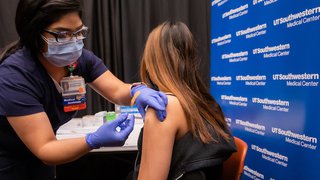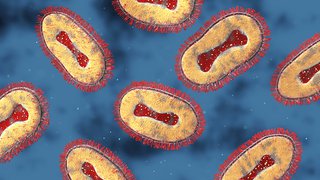Children and teachers in North Texas are heading back to school this month, but the emergence of the highly contagious Delta variant and rapidly rising COVID-19 case counts – even among children – have fueled new concerns about the safety of in-person learning.
Mixed messages about masking, vaccines, and the pandemic have further complicated matters.
Recently, I joined Dr. John Warner, UT Southwestern’s Executive Vice President for Health System Affairs, and Dr. Joan Buchanan Hill, head of the Lamplighter school in Dallas, for an episode of UTSW’s web series “What to Know.” We discussed how the Delta variant and more environmental factors will impact this school year, and offered strategies to help parents keep their children safe.
Please find the episode above, and below is an edited transcript of some of my responses to Dr. Warner’s questions.
Q: How dangerous is the Delta variant for children, and how does it differ from the original strain?
A. The Delta variant is quite worrisome. It's virulence – its ability to cause disease and to kill people – may prove to be about the same as the original SARS-CoV-2. But Delta is a more fit virus; it spreads much more quickly.
A year ago, if you were infected with COVID-19 we predicted you would transmit the disease to a little more than two people if you were in a room together with no masks. Today, if you are infected with the Delta variant and you’re not vaccinated or masked, you’re likely to infect a little more than five people. And each of those people could then infect five people, and so on. As of Aug. 5, hospitalizations in Texas were rising at the fastest rate since the pandemic began, including among children and people under age 20, according to the Texas Department of State Health Services. Children under 12, who aren’t yet eligible for COVID-19 vaccines and are less likely to suffer severe complications from the disease, are contributing to the trajectory of the spread.
Estimates are that about 97 percent of patients hospitalized nationwide are unvaccinated.
We're in a race with this virus, and the race just got radically faster. The Delta variant could be a real game changer. It’s going to have profound public health and epidemiologic implications.
Q: With vaccinated and unvaccinated people in classrooms, what’s your advice for parents and kids?

A. Getting vaccinated is the best counter measure by far; anyone 12 and older is eligible. If the people around you can get vaccinated, that helps, too, because the main concern with the Delta variant is that it's going to rip through our population and spread faster than we can keep up.
Vaccination remains our most important tool to counter this pandemic. If you can't get vaccinated, the CDC has done a thoughtful job of recommending layers of protections. Those include familiar, additional mitigation strategies:
- Wearing masks indoors
- Staying outdoors as much as possible
- Maintaining physical distance
- Limiting your contacts, particularly with unvaccinated individuals
- Washing or sanitizing your hands frequently
The CDC and the American Academy of Pediatrics recommend that all students and staff wear masks in school.
Having children and teachers back at school, mixing people from different homes, will be challenging. We must continue to take the Delta variant and this pandemic very seriously and encourage anyone who is eligible to get vaccinated.
Q: How should parents talk to kids about staying safe at school?
A. This may be a historically significant opportunity to have conversations with kids that may make them a wonderfully enlightened generation.
People want to do the right thing, and it's been confusing because the recommendations have changed as the pandemic has evolved. But having conversations with children about why it makes sense to wear a mask in school, or wash your hands is important. Because it teaches children how to help protect others, including in school where they have meaningful connections to their teachers and friends. Telling them that the mask isn’t just for you, it's for your teacher, or your teacher's mother, is an effective message – particularly with young children.
By teaching young people public health concepts and how a virus spreads, we may look back on this decades from now and realize that this generation is the most informed about virology and epidemiology because of the experience they went through today.
Q: When can we expect vaccinations to be available for kids under 12?
A. I wish we had them now, but if I were to guess we probably won't have FDA approval before the end of this year or the beginning of next year. Of course, after it comes out people have to get it. So we're going to have to start this school year with a new variant and many of our population without vaccines. And then a particularly tricky part of this is many children have COVID and don't show symptoms, which is one of the things that makes this quite challenging.
Q: When should parents keep children home from school with symptoms?
A. There are some epidemiologic differences depending on where you live – communities with more vaccinated residents have less opportunity for the Delta strain to spread quickly – but the CDC recommends if your child is sick, they should stay home. So that's where I'd start.
Delta variant symptoms, according to the CDC, are:
- Fever or chills
- Cough
- Shortness of breath or difficulty breathing
- Fatigue
- Muscle or body aches
- Headache
- New loss of taste or smell
- Sore throat
- Congestion or runny nose
- Nausea or vomiting
- Diarrhea
If your child has any of those symptoms, you should consider keeping them home and getting them tested for COVID-19. There are special situations where I could imagine someone having something other than COVID-19 – symptom related to asthma, for instance – and you'd hate to have them miss important developmental opportunities just because of that. In those instances, check with your pediatrician before sending the child to school.
Q: What does the future of the COVID-19 pandemic look like to you?
A. I don't think this is going to be done soon. Other coronaviruses circulate perpetually in the environment, but they aren't deadly like this one.
There are several scientific and biologic reasons why this is not a virus that we would eradicate. It has animal hosts, it mutates, it's highly transmissible. People have silent infections. I think the best hope is as humans, we're going to learn to work together to get better at diagnosing, tracking, and treating COVID-19.
I know it feels as if we've been living with this virus for a long time, and it’s natural to wonder how long it’s going to go on. But I’d say we have a long way to go, and we have to learn how to be even more resilient and responsive to it.
Q: Is there any silver lining for this school year?
A. While it can be frustrating that we are starting another school year living with COVID-19, it's also important that we don't forget how much better off we are as a species to address these challenges.
This year, we have vaccines, they work; we have testing, it's faster; we're able to identify different strains and understand what they mean. We know masks, physical distancing, and hand washing work, so we must remain vigilant in terms of continuing to employ those mitigation strategies to reduce the spread of the virus. The pandemic is still with us. But I think this is an opportunity for us as people to really come together and look out for each other.
I have a sister who's a middle school art teacher. She's going to be on the front line, just like doctors and nurses. Together we can do this. Preserving our education and development is one of the things that keeps me going, and doing it responsibly, thoughtfully, and responsively to the new data is how I think we're going to get through this.











